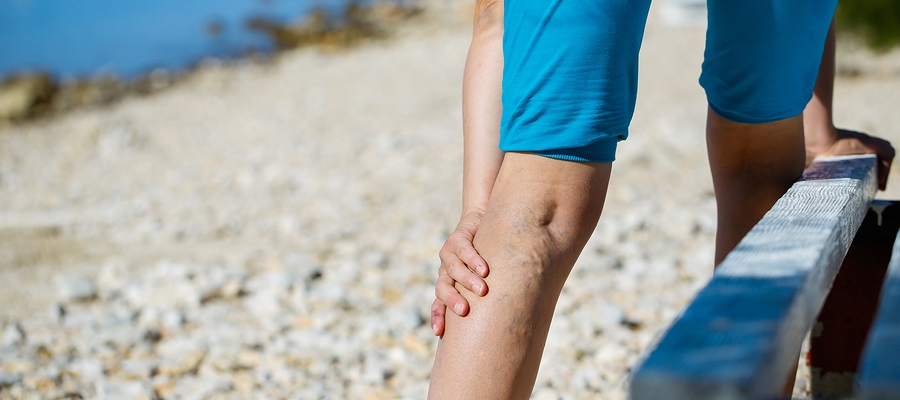
The first sign of a varicose vein is swelling along the path the vein takes down the leg. After this most people notice bluish or reddish tinged coloring to the area as well as a swelling along the vein. Varicose veins are the result of damaged one way valves that help push the blood through the veins and forward to the heart. When the valves become damaged, the blood is able to pool within the veins and decreases the ability of the body to remove toxins and oxygenate the tissues. (1)
At this time, traditional Western medicine believes that sclerotherapy is the gold standard for treating varicose veins. However, some insurance companies do not cover this expense if there are no other underlying medical symptoms. And, some women would like to try other more natural remedies in order to treat their varicose veins and prevent any further from occurring.
Many women find their varicose veins have a genetic predisposition. In other words, there were other men or women in the family who suffered from varicose veins in years past. This meant that the valves in the veins were predisposed to being weaker and giving them trouble. However, by using some of the preventative measures outlined below many times men and women are able to significantly reduce their risk of developing spider veins or varicose veins.
Prior to trying any of these homeopathic alternative treatments it is important to check with your primary care physician to ensure that you will not negatively impact any other underlying medical condition.
One of the reasons that varicose veins and spider veins will form is because the muscle contractions required to move the blood through the venous system are not strong enough and the blood begins to pool. In response to this, many women and men find that doing calf raises and other exercises for the lower extremities throughout the day will help to improve muscle strength and therefore the venous pump system.
Calf raises are done either on a stair or on a set of stacked books. Put your toes on the edge of the steps or the ball of your foot on a couple of stacked books and raise and lower your entire body using only the ball of your foot. This exercise works the calf muscle which plays a significant role in the venous pump system.
Try working up to 50 to 100 calf raises each day as well as raising up on the toes from time to time throughout the day. In response to the development of these calf muscles you must also stretch them. This can be accomplished by placing one leg behind the other approximately 6 to 8 inches from the solid wall. Place your hands on the wall, with your knee of the extended leg straight and your other knee bent, lean into the wall. You should feel the calf muscle begin to stretch.
Walking is another exercise that can be done, rain or shine, every single day, in order to improve the muscle development in the lower extremities. Walking aids the return of the venous blood, not only during the walk but also for several hours afterwards.
When you find you will be sitting or standing for any length of time be sure to make it a point to get up every 10 to 15 minutes and move around. If your job entails standing in one place, then be sure to do some calf raises and move your legs at least every 10 minutes. Once you get home, prop your legs up above the level of your heart for at least 30 minutes to help improve the flow of blood through the venous system.
Compression stockings are another means of improving circulation and have been the mainstay of treatment for varicose veins for decades. Compression stockings can also be used to prevent the formation of varicose veins, especially when you know there is a genetic predisposition to the condition. Individuals who suffer from varicose veins will also experience some relief from symptoms using compresison stockins. (2,3)
Excess weight is another risk factor that significantly changes the percentage of individuals who will develop varicose veins or spider veins. By exercising and controlling your weight you will also improve the circulation of blood in your legs and decrease the amount of pressure placed on the valves.
Another way of maintaining an appropriate weight is to eat a balanced diet. The nutrients may also help prevent varicose veins. For example, vitamin C and protein are both components of the production of collagen. Collagen, while a significant factor in anti-aging products, is also one part of the development of veins and valves. If you have enough collagen in your veins and valves and in good shape, you are more likely to be resilient to varicose veins.
While standing for too long can be an issue, so can sitting. Some experts theorize that even sitting for extended periods can contribute to the development of varicose veins. The theory is that the bending of knees and hips will slow the return of blood to the heart. So, it is very important that during any long car ride or plane ride or anytime you are sitting behind your desk you can also routinely move your legs, rotates your ankles and clench your toes.
While sitting can create greater pressure in the lower extremities, crossing your legs will slow the circulation even further. Remember that if you want to cross your legs, they should be crossed at the ankles only. Crossing at the knees not only causes increased pressure and increases the risk of closing the veins, but it also negatively impacts any problems with the knees and hips.
If you know you have a genetic predisposition to varicose veins, or have some chronic swelling in the lower legs already, it is helpful to sleep with a few pillows under your feet in order to keep them elevated above the level of your heart. Look for shoes that have lower heals that require the calf muscles to do more work. Some of the new tennis shoes, now being produced for women who want to increase their caloric burn while walking, are also helpful for women and men who want to treat and prevent varicose veins.
Don’t wear underwear that are tight at the waist or in the groin. This acts as a tourniquet that restricts blood flow and can not only increase your risk of developing varicose veins, but can also increase your risk of developing cellulite.
Some women find that the use of vitamin E, witch hazel or Apple cider vinegar can help reduce the effects of varicose veins or spider veins when applied to the skin in the morning or evening. The herb horse chestnut is another of the most widely used natural treatments for spider or varicose veins. The active compound appears to block the release of enzymes that damage the capillary walls.
Researchers in a 2006 study found that individuals who used horse chestnut had improvements in the signs and symptoms of venous insufficiency, including spider veins and varicose veins. There were some adverse events which were usually mild and infrequent and included nausea, vomiting, diarrhea, headache. Individuals who choose to take horse chestnut should do so from a reputable dealer since there is a toxic component which must be removed prior to sale and can cause circulatory and respiratory failure or even death. (4)
Grape seed extract and pine bark both contain anti-oxidants that appear to strengthen the connective tissue and reduce inflammation. The most common side effects are digestive complaints such as nausea and upset stomach. But people who have an autoimmune condition, such as rheumatoid arthritis or Crohn’s disease, should not take either grape seed extract or pine bark because of its effects on the immune system. (5,6)
And lastly, Reflexology is a form of therapy that focuses primarily on the feet. This form of medical treatment was studying with pregnant women and showed significant reduction in leg swelling. Reflexology has little adverse side effects but must be applied by a a trained practitioner in order to receive maximum benefits.
(1) WomensHealth.gov: Varicose Veins and Spider Veins Fact Sheet
(2) Mayoclinic.com: Varicose Veins
(3) Phlebology: A Systematic Review of Compression Hosiery for Uncomplicated Varicose Veins
(4) Medline Plus: Horse Chestnut





